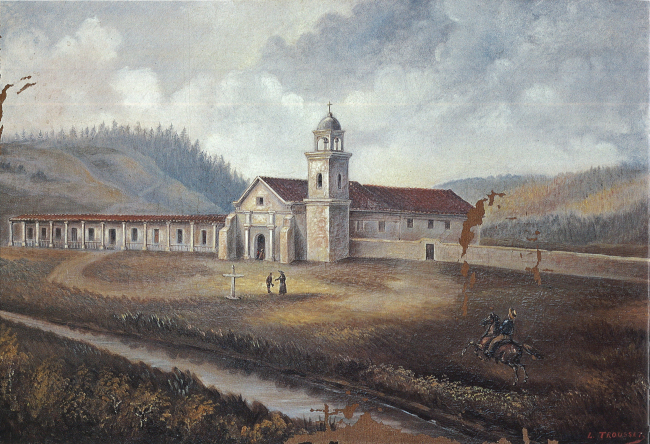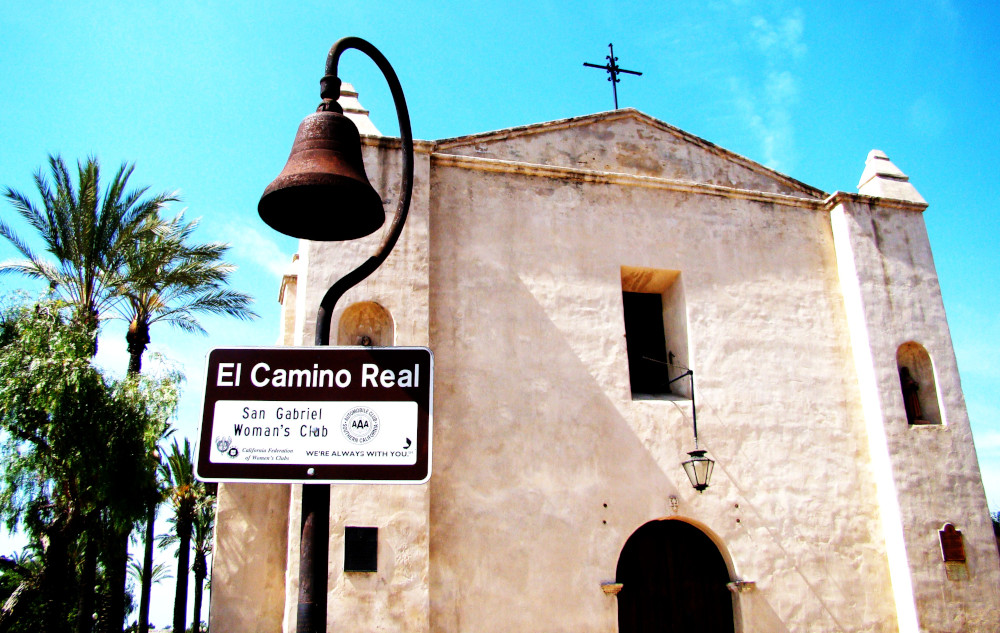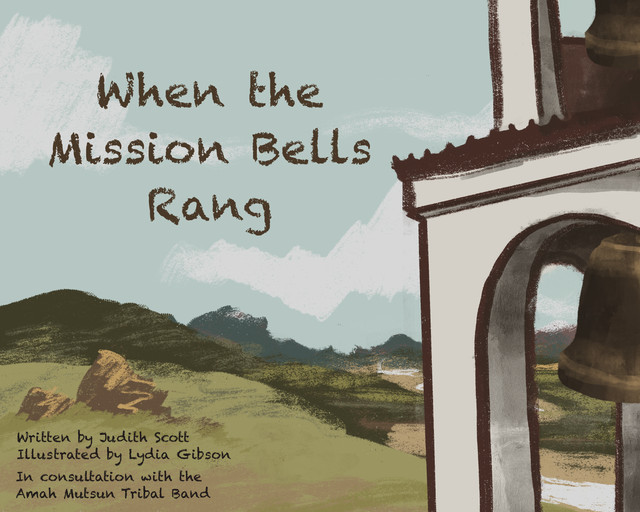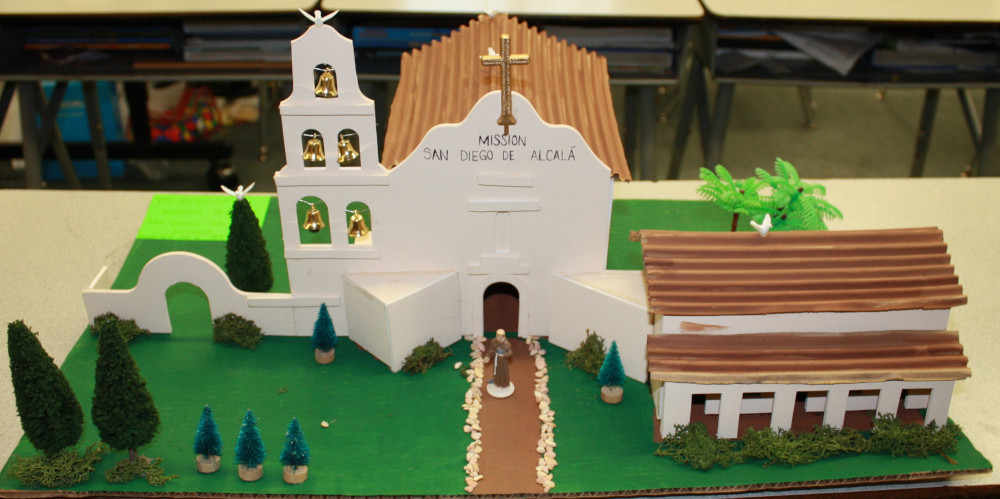
Disputed memories
Why do they hide the bad things?
On June 10, 2020, Martin Rizzo-Martinez (Ph.D. ‘16) was less than two weeks into his new job as park historian for the Santa Cruz County Parks when history marched right up to his doorstep. Protesters against the murder of George Floyd swept up from downtown to the Santa Cruz Mission Plaza, toppled a mission bell marker, and spray-painted the mission walls and a memorial plaque with the word “genocide.”
On the day after the protest, Rizzo-Martinez said, “I was out there scrubbing the walls with my colleagues.” (The Parks Department owns the site of the mission adobe and was responsible for the cleanup.) But Rizzo-Martinez, who has documented the appalling loss of life by Native Americans during the Spanish mission period, most notably with his recently published book We Are Not Animals (University of Nebraska Press, 2022), would be the last person to disagree with the protesters.

In an earlier era, the Parks Department might have bemoaned the vandalism. But this was 2020. Instead of criticizing, they listened. Rizzo-Martinez and his Parks Department colleagues looked for ways to “rethink how the story has been told.” Their response, designed in consultation with local Native American groups, produced a remarkable virtual exhibit on the history of the mission bells. “I understand that when you remove a marker, people are afraid of erasing history,” Rizzo-Martinez said. “So, the exhibit we built includes six different perspectives of what the bells have meant to different communities over time.”
The George Floyd murder prompted a reckoning for the entire United States over its history of violence against people of color. While a great deal of attention has focused on Confederate memorials in the Southeast, California has its own set of problematic memorials: more than 500 mission bell replicas that line the state’s highways. For Indigenous people, they are a reminder of a brutal period. At Mission Santa Cruz alone, 2,078 of the 2,289 Native Americans who were baptized were also buried there, an appalling death rate of 90% over a 40-year period. Half the children died before age one and three-quarters died before age five. Eyewitness accounts testify to abusive treatment of the natives by the padres. These facts are not taught in schools, and they are not widely known by the public. Rizzo-Martinez and faculty and students at UC Santa Cruz are trying to change that.
A fuller story

In 2018, UCSC joined three other University of California campuses and several Native American tribes to launch a project called Critical Mission Studies, which aims to tell a fuller story of the Spanish mission era. UCSC has had a long partnership with the Amah Mutsun Tribal Band, the Indigenous descendants of several original tribes often forcibly taken to Mission Santa Cruz and Mission San Juan Bautista. “Our goal is to have the true history of the missions told,” said Valentin Lopez, chairman of the Amah Mutsun. “Whenever I would talk about the history of the missions, people could not believe it. The Critical Mission Studies project is allowing tribes and individuals to tell the story. It was just natural for us to work with UCSC on this effort. We’re grateful and feel we are accomplishing our goals.”
The project was conceived by UCLA Art History Professor Charlene Villaseñor Black, UC Riverside History Professor Jennifer Scheper Hughes, UCSC History Associate Professor Amy Lonetree, and UC San Diego Ethnic Studies Associate Professor Ross Frank, who jointly applied for a grant as part of the Multicampus Research Programs and Initiatives (MRPI). One of only 16 grants funded out of 179 applications, their proposal received slightly over $1 million. But it is not the size of the grant that makes it unique. “It really became special when Native Americans were brought in as co-supervisors,” said Rizzo-Martinez. The four co-principal investigators share all decision-making with four representatives of California Native tribes, including Lopez and Yve Chavez, UCSC assistant professor of art history and a member of the Southern California Tongva tribe. “We listen to the community and do not come in with our idea of what they should care about,” said Lonetree, who handed over her co-principal investigator duties to Anthropology Professor Renya Ramirez after the grant was funded.
The grant funds a diverse set of projects. In one, Amah Mutsun Ph.D. students Alexii Sigona (UC Berkeley) and Carolyn Rodriguez (B.A. ‘18, now at UCLA) conducted oral history interviews with 11 members of the Amah Mutsun; clips from these interviews are being made available as a resource to elementary school teachers. In another, Rizzo-Martinez is working on Walk for the Ancestors, a film documenting a 780-mile walking journey that Caroline Ward Holland, a woman from the Los Angeles–based Tataviam Tribe, took with her teenaged son, Kagen, in 2015 to visit and hold ceremonies with local tribe members at each of the 21 Spanish missions.
The grant also funded a one-day conference in August 2021, held at Mission Santa Cruz. Called “Telling and Teaching the Truth of the California Missions,” the gathering included a ceremony to celebrate the removal of the mission bell the following day. Ramirez described it as a “catharsis” for the Amah Mutsun and others. “I was surprised about how emotional it was, to be at that site giving a talk,” said Lonetree. “I’ve heard the history recounted before, but there is something powerful and very poignant about hearing it in the space where it happened.”

Popsicle-stick missions
Other related activities at UCSC focus on an important group that urgently needs to hear the Native side of mission history: California’s children. Judith Scott, professor of education, wrote and self-published a children’s book, called When the Mission Bells Rang (2022; free PDF available at link). The child-friendly fantasy features animals that join together to foil the padres’ attempts to ring the bells. The story incorporates Indigenous folklore and uses Amah Mutsun names for the animals; it also includes aspects of recorded history, such as an earthquake in 1840 that destroyed the mission’s bell tower. “It’s a great way to get kids engaged, and to start creating curiosity,” Scott said.
For more than 50 years, as part of their required, standard curriculum, all California public school students have learned about the Spanish missions in the fourth grade, traditionally including the activity of building models of the missions out of popsicle sticks and other materials. But their textbooks typically portray the Native Americans as docile converts to Christianity, a representation that is offensive to those who know better.
Unfortunately, textbook publishers have done little to change this narrative. But in focus groups she collaboratively conducted as part of the grant, Daisy Martin, director of the Education Department’s History & Civics Project, said she consistently heard pleas from teachers: “We want Native voices, where can we find them?” The Critical Missions Project will provide those teachers with teaching plans and classroom resources, such as the previously mentioned clips from the Amah Mutsun oral histories.
Meanwhile, the California Department of Education is finally working on a long overdue statewide curriculum on Native American history, expected to be completed in 2025. Some of the materials produced by Martin, Scott, and their colleagues could become part of the new curriculum. However, “One of the difficulties in trying to teach a generic history is that there are no generic tribes,” said Scott. To address this issue, educators in other counties will have to reach out to their local tribes to hear their stories, a process that the Critical Missions Project hopes to facilitate by providing a roadmap and helping them make the connections.
Barbara Novelli, a fourth-grade teacher at Bay View School in Santa Cruz, has field-tested Scott’s book and other materials. Kids at that age are very attuned to fairness and injustice, she said, and they notice how their textbooks duck the issue. Novelli recalled one child asking, “I’ve read about Mission Santa Cruz before. Why did they hide the bad things from us?”
Facing the bad things
The reality is that adults often find it more difficult to face the “bad things” than children. In Santa Cruz, Lopez worked for two years to get the removal of Santa Cruz’s last mission bell onto the city council’s agenda, finally achieving a unanimous 5-0 vote to remove the bell. In Gilroy, however, the opposite happened when its council considered a proposal to erect a new bell marker in honor of the city’s 150^th^ anniversary. “I believe 40 letters were sent to them, some very powerful, from university professors and local citizens,” Lopez said. “It was obvious at the hearing that the council members hadn’t even read the letters.” Lopez was allotted one minute to speak, not enough time to convince someone that what they have been taught for their entire life is wrong. “They have no doubt they are correct,” Lopez said. “And they are unwilling to even contemplate anything else.” The council voted 4 to 3 in favor of the new mission bell.
“The educational process is going to take a very long time,” said Lopez. “We know it could take generations, so it’s important to get started as soon as we possibly can, to work diligently and persistently, and never give up on getting the truth told.”

